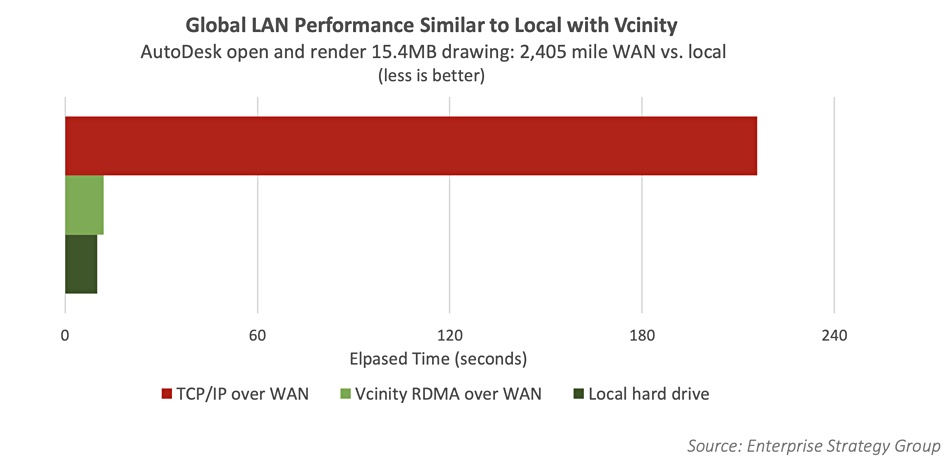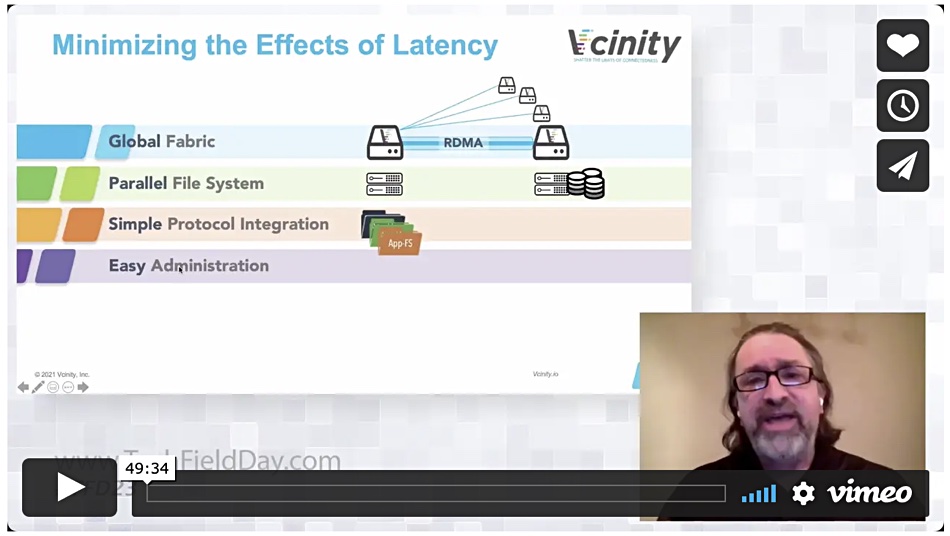Vcinity’s Data Access Platform (VDAP) defeats remote data gravity, providing local disk access speed to data at inter-continental distances.
It goes against the perceived wisdom by not moving entire datasets to compute. Instead it shifts chunks of data using remote direct memory access (RDMA) inside IP packets across global distances and enables real-time compute on data thousands of miles away. Don’t cache and store the compressed and deduped distant data locally, like cloud file gateways such as Egnyte, Nasuni and Panzura. Don’t physically move disk drives like Seagate’s Lyve Mobile or AWS Snowball.
We wrote about the privately-owned company in March two years ago. In April it presented at Tech Field Day. In June it hired an SVP for Worldwide Sales and also a Chief Strategy Officer — both moves signalling its intention to bulk up its presence in the market. How does it do what it does, and why — if the technology is so good — isn’t it more popular?
Gateway devices
Vcinity provides two gateway devices, one either end of a wide area link. (“Gateway” is our term, not one used by Vcinity by the way.) These devices can be appliances or virtual machines. They run on Linux and implement IBM’s Spectrum Scale parallel file system. A client system mounts its Vcinity device as an NFS or SMB file system and reads or writes data to/from the remote file share via its inline Vcinity device.
There is no traditional WAN optimisation. The data is not compressed or deduplicated, nor cached or stored at the target end of the link. From the outside, a Vcinity link is a drop-in and dumb but high-speed pipe that needs no change in applications accessing NFS or SMB file data.
There can be from three to eight network links between the two Vcinity devices, with data striped across them. (Each link can have a separate encryption method if so desired to increase security.) When data is requested or sent an RDMA protocol is used between the two Vcinity gateways, but the data is split into chunks and sent as an IP packet with IP headers — so that standard IP networks can handle the traffic flow control and provide lost packet recovery. VDAP is a lossless protocol.

The RDMA can run across RoCE or InfiniBand. Because TCP/IP is not used as the transport, all of its chattiness (network overhead) is sidestepped and up to 95 per cent of a link’s bandwidth can be used by Vcinity and sustained. When a chunk of data is sent across the link the time to the first bit can be 70ms, according to an ESG validation report. But after that, data just streams across the link, as if coming through a fire hose.
Test results
ESG’s testers compared Vcinity’s data movement with TCP/IP and found a substantial improvement.
For example: “Vcinity was 94 per cent faster than TCP/IP when accessing a data set that was 2,405 miles away (29 seconds compared with 7 minutes and 42 seconds).” The ESG people said. “As … seismic data scientists had reported, accessing data located thousands of miles away was, for all intents and purposes, as fast as accessing data stored locally.”
In another test, they “compared the time that it took to open and render a 15MB AutoDesk rendering of a ship design in a local directory to the time that it took to open and render the same file located more than 2,000 miles away, using both Vcinity and traditional TCP/IP … the elapsed time using Vcinity 1000V was 95 per cent faster than the TCP/IP method (12 seconds versus 3 minutes and 36 seconds) and only 2 seconds slower than the local method.”

In ESG’s view the “Vcinity ULT X [device] turns your WAN into a global LAN with RDMA over WAN technology that skips layers of the TCP/IP stack and delivers near real-time access to industry standard NFS and SMB file shares over long distances.”
Comment
Vcinity provides the equivalent of LAN access to disk drive data across WAN distances. It does not provide the equivalent of NVMe-over-Fabrics access to data stored on NVMe SSDs. We think that Vcinity is chasing down opportunities where real-time access is needed to large files stored remotely, and it is not inexpensive. However it is cost-justified when expensive technical staff can get to work on data days faster than before and keep expensive remote data-generating assets, like oil drilling ships, operating more effectively.

Read up an a Vcinity data sheet here. Watch a Vcinity Tech Field Day video by Vcinity CTO Stephen Wallo here. about its VDAP. He gives a good explanation and answers lots of questions from the delegates.
Perhaps you will find that you don’t have to move terabytes of data long distances to have your technical staff and applications access it. Instead keep a single, golden copy, and have them access it remotely, as if they were in its vicinity. (Apologies for awful pun — ed.)








